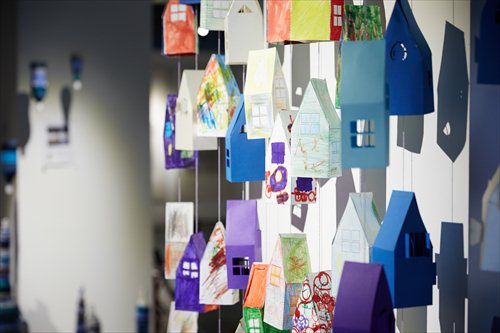
One of the pieces on show at the exhibition (Photo/Courtesy of Singapore International Foundation)
With Art of Sustainability, an exhibition under the umbrella of the Arts for Good program, four Shanghainese and four Singaporean artists collaborate to demonstrate the power of art for positive social change.
The Singapore International Foundation, which launched the program, believes that the arts and culture are the best approaches to address social issues - they connect across cultures to break down barriers and inspire a shared responsibility for collective action.
All these exhibits were specially created - the Shanghai artists visited Singapore in March and the Singaporean artists visited Shanghai in June to engage with local institutes and communities and gain a better understanding of sustainability and community development.
The Singaporean artists also created their works after visiting the host venue, The Rhythm, where the exhibition will run until September 25.
Co-curator Fu Jun, from the Shanghai team, said both cities faced similar problems including traffic congestion, housing shortages and environment deterioration, though Singapore was a perfect example of a livable city with a high population density.
A city's tenderness
She saw the theme of the exhibition "Pulse of a City" as the tenderness of a city's humanity rather than a heart in a physical sense.
She believes the "softly" and "tactfully" aspects displaying the tenderness of the two cities and this is where the viewers can find humanity, love, and pain in their own experiences or urban life.
It was interesting to find that all the Singaporean artists chose to create installations, while their Chinese counterparts produced paintings.
Mao Donghua, for example, reflects on historical urban resources with water ink paintings of the Fairmont Peace Hotel on the Bund, while Du Haijun offers oil paintings of Shanghai subways to illustrate urban congestion.
Looking into history
One of the exhibition's highlights comes from Zhang Yue. In her City Memory series, she has painted people from different walks of life in watercolors, and then framed them with windows she rescued from some of the old, damp and musty building ruins in the city.
"I think it is a process of looking into history, in which the soul of a city can be located. For it seems that both the people and buildings have lost their souls in this ever-changing city," Zhang said.
Fu suggested that the Shanghai artists' works explore the cities' historical remains, observing today's city life and current urban culture.
"Moreover, they enable viewers to directly experience the cities' historical heritage, its current situation, and the course of development through the years," Fu said.
Allan Lim, the curator for the Singaporean team, told the Global Times that he thought one advantage the Singaporean artists had was their diversity.
He cited Karen Mitchell's reflections on urban housing, Didier Ng's representation of the amount of trash generated in cities, Tan Sock Fong's invitation for communities to participate in sustainable practices, and Kenneth Lee's questions about urban identity.
Engaging the community
"The collection of installations by Singaporeans as a whole examines the different issues of urban living, with a special focus on engaging the community by involving it in the actual creation of the artworks or through inviting them to participate in the artwork to spread awareness about key issues faced by our cities," Lim said.
Karen Mitchell's installation Life Residency consists of three-dimensional paper houses of different sizes and colors, suspended from the ceiling.
"The different models of houses do not represent any particular city, but rather the fantasy houses people drew as children. The houses do not have doors, as there is no need to enter or exit," Mitchell explained.
Small areas of these houses have been decorated by young students from the Shanghai Fei Ye Art Special Education for Children and the Shanghai Xing Yu Intellectual Training Center.
Mitchell said their creations made her work more unique. "Life stories are created within and outside the houses, keeping the city alive," she said.
Didier Ng said the Singaporean artists came from similar backgrounds as the Chinese counterparts.
"Through this exchange, we can see how people in Shanghai work and they can see how we in Singapore work. What are the differences, and why are there differences? This goes back to looking at how we live and linking it back to art, which will determine how the art we produce will ultimately be perceived and received," Ng said.


















































